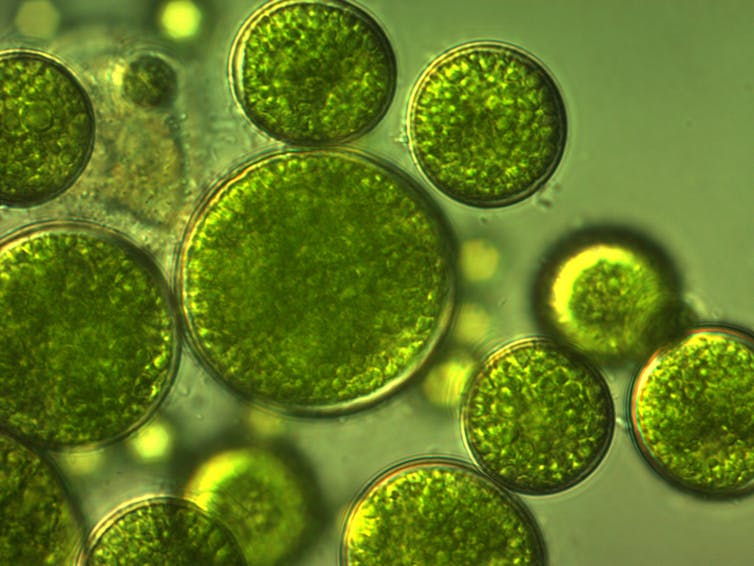
In recent decades, algae have garnered significant attention from the scientific community due to their remarkable ability to address two of the world’s most pressing challenges: mitigating climate change and producing sustainable resources.
These organisms can capture carbon dioxide (CO2) from the atmosphere. However, it is their capacity, through a series of processes, to convert the captured CO2 into mass-produced proteins, lipids, and carbohydrates that piques the interest of scientists.
As we grapple with rising greenhouse gas emissions and diminishing natural resources, algae have emerged as a promising solution with the potential to revolutionize various industries.
A scientific review published by researchers from the University of Houston, Old Dominion University, Michigan State University, and Cranfield University describes different sources of CO2 emissions and capture technologies, including microalgae.
The document outlines the details of methods for cultivating and separating algal biomass, followed by thermochemical and biochemical conversion into fuels/chemicals, bioplastics derived from microalgae, and plastic blended with microalgae biomass.
Researchers also explored the conversion of microalgae into fuels, chemicals, bioplastics, and the potential of algae-infused plastics. They examined the commercial viability of continuous biorefining processes and the environmental benefits of using microalgae for carbon sequestration and wastewater treatment.
Algae as Carbon Sequestration Champions
In a world grappling with increasing CO2 emissions, the ability of microalgae to capture and convert this greenhouse gas changes the game. Industries like coal-fired power plants, cement production, steel manufacturing, and petroleum refineries are major contributors to CO2 emissions. However, microalgae offer a sustainable alternative to combat these emissions.
Harnessing the power of these small organisms allows us to capture flue gases containing CO2 and reduce their impact on the environment.
Stay Always Informed
Join our communities to instantly receive the most important news, reports, and analysis from the aquaculture industry.
Algae: The Center of Sustainable Resources
Apart from their role as carbon sinks, algae also play a fundamental role in sustainable resource production.
The research evaluates the potential of using microalgae for wastewater treatment and using algal biomass to produce food, fertilizers, fuels, and chemicals. Algae cultivated in freshwater treatments, such as spirulina, are used in cosmetics and health supplements. In the future, microalgae could be used as a sustainable raw material for producing biofuels and biochemicals, reducing dependence on fossil fuels.
Algae’s ability to use nutrients such as nitrates, phosphates, and other micronutrients in the water allows them to rapidly increase their biomass.
Researchers have been exploring various methods for cultivating and separating algal biomass, followed by its thermochemical and biochemical conversion into a variety of products.
Microalgae-Derived Bioplastics and Green Plastics
As the world seeks alternatives to petroleum-derived plastics, microalgae have taken the spotlight. They offer a unique avenue for producing bioplastics that are biodegradable and environmentally friendly. The combination of microalgae biomass with traditional plastics is an intriguing prospect, providing a more sustainable option in the plastics industry.
Commercially Viable Biorefining Processes
Sustainability and economic viability often go hand in hand. Continuous and semi-continuous biorefining processes, such as hydrothermal flash hydrolysis, have the potential to make algae-based production commercially viable. These processes convert algal biomass into fuels, chemicals, and other valuable resources while minimizing waste and environmental impact.
Environmental Benefits of Algae
Beyond their role as carbon sinks, microalgae also hold significant promise in wastewater treatment. Algae can efficiently remove pollutants from wastewater, providing a cost-effective and environmentally friendly solution for water purification.
Conclusion
The potential of algae to capture CO2, produce renewable resources, and contribute to environmental remediation is becoming increasingly evident. The scientific community’s relentless pursuit of understanding and harnessing algae’s potential underscores their importance in addressing global challenges.
As industries and governments increasingly focus on reducing greenhouse gas emissions and transitioning to sustainable practices, the importance of algae will continue to grow. It is a testament to the power of nature, which, when harnessed responsibly, has the potential to reshape our world for the better.
Contact
Venkatesh Balan
Department of Engineering Technology, Cullen College of Engineering, University of Houston, Sugarland, TX 77479, USA
E-mail: vbalan@uh.edu
Tel: +(1) 713 (743)-6640
Reference
Balan, V., Pierson, J., Husain, H., Kumar, S., Saffron, C., & Kumar, V. (2023). Potential of using microalgae to sequester carbon dioxide and processing to bioproducts. Green Chemistry.
Editor at the digital magazine AquaHoy. He holds a degree in Aquaculture Biology from the National University of Santa (UNS) and a Master’s degree in Science and Innovation Management from the Polytechnic University of Valencia, with postgraduate diplomas in Business Innovation and Innovation Management. He possesses extensive experience in the aquaculture and fisheries sector, having led the Fisheries Innovation Unit of the National Program for Innovation in Fisheries and Aquaculture (PNIPA). He has served as a senior consultant in technology watch, an innovation project formulator and advisor, and a lecturer at UNS. He is a member of the Peruvian College of Biologists and was recognized by the World Aquaculture Society (WAS) in 2016 for his contribution to aquaculture.




